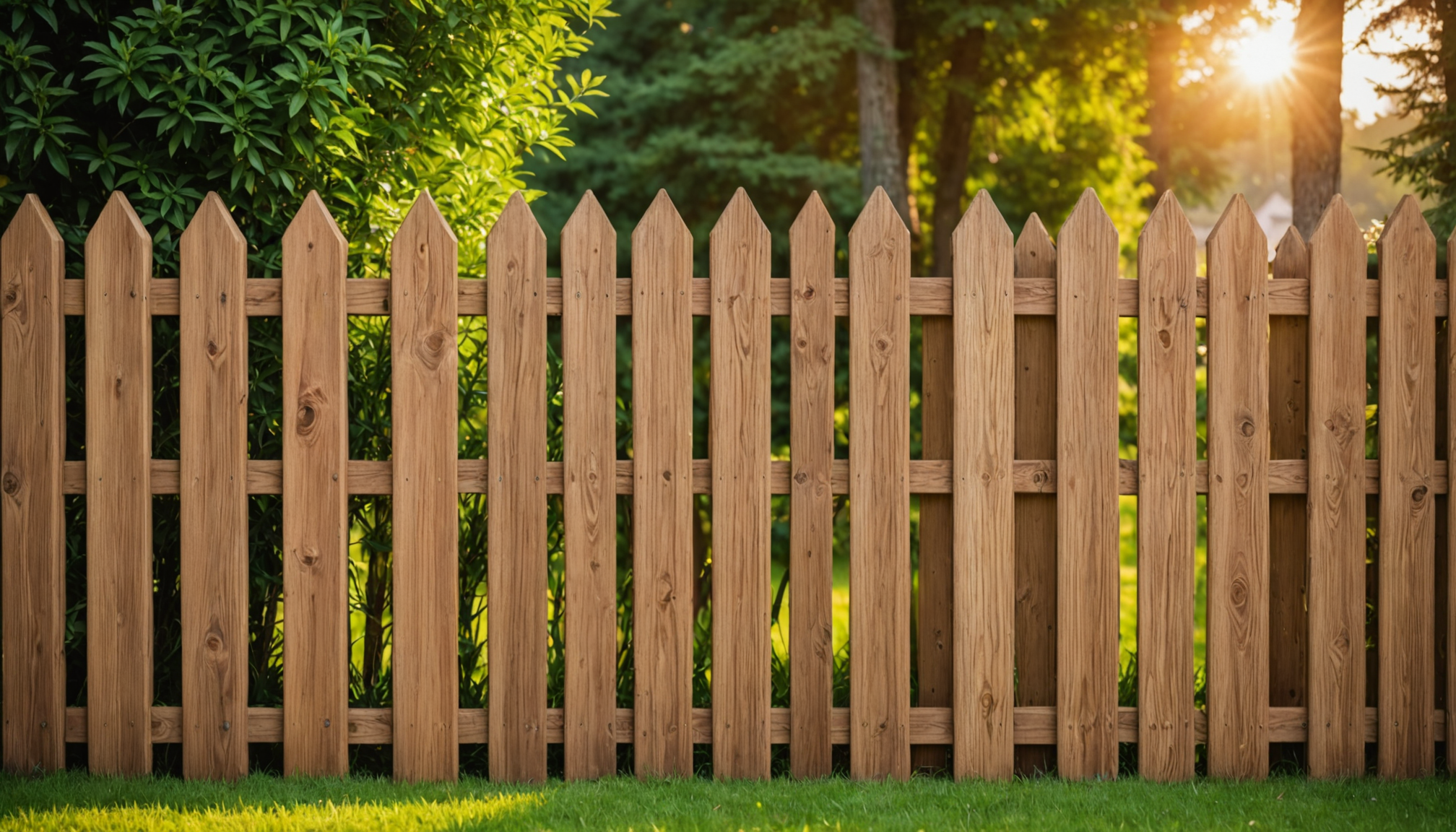Choosing the right material for your fence is a critical decision that affects not only the aesthetics but also the functionality and longevity of the structure. Each material comes with its own set of benefits and limitations, and understanding these can help ensure that your fence meets your needs effectively. In particular, thoughtfully evaluating various options will allow you to organize your project efficiently, potentially saving time and resources in the long run.
Wood Fencing: Classic and Versatile
Wood is perhaps the most traditional choice. It’s admired for its natural beauty and versatility. There are numerous options available, from cedar and pine to redwood, each with distinctive grains, colors, and durability levels. A wooden fence can bring warmth and classic appeal to any property, and it can be painted or stained to suit any landscape design.
| Wood Type | Durability | Maintenance | Cost |
| Cedar | High | Moderate | Moderate to High |
| Pine | Medium | High | Low to Moderate |
| Redwood | Very High | Low | High |
However, wood fencing requires regular maintenance to prevent decay and ensure longevity. Treatments like weatherproofing and termite prevention become essential. As an eco-friendly option, sourcing responsibly managed timber can help reduce environmental impact.
Vinyl Fencing: Durable and Low Maintenance
Vinyl fencing has gained popularity due to its resilience and minimal upkeep. Made from polyvinyl chloride (PVC), it is resistant to weather elements, insects, and rot. This type of fencing comes in various styles and colors, emulating the look of wood without the corresponding maintenance responsibilities.
The upfront cost of vinyl can be higher than wood, but the long-term savings on maintenance and repairs often justify the investment. Additionally, vinyl is an excellent choice for those seeking an eco-friendly option within synthetic materials, as some manufacturers offer recycled vinyl products.
Metal Fencing: Strength and Security
Metal fences, including aluminum and wrought iron, are renowned for their strength and security. These materials provide an imposing boundary that is difficult to breach, while also offering an attractive appearance. Aluminum is lighter and rust-resistant, making it a practical choice for those near coastal areas, while wrought iron provides a classic and elegant look that can last a lifetime with proper maintenance.
Metal fences can be enhanced with electrical features for added security, making them a favored choice for those looking for high-security applications. While the cost may be significant, the durability and minimal maintenance needs are appealing to many homeowners.
Composite Fencing: Blending Aesthetics and Innovation
Composite fencing combines recycled wood fibers and plastic, giving you the appearance of wood with the durability and ease of maintenance typical of synthetic materials. This makes it an attractive eco-friendly option for those seeking both appearance and practicality. Composite fences do not require painting or staining and are resistant to warping, insects, and moisture.
- Low Maintenance: Simply wash with soap and water as needed.
- Wide Variety of Styles: Available in numerous colors and textures.
When considering which material to choose, think about your priorities regarding aesthetics, maintenance, sustainability, and budget. Staying organized through research and planning before committing to a specific fence material will help ensure the completion of a successful and satisfying fencing project from start to finish. If in doubt, consider hiring pros for expert advice tailored to your specific needs and site constraints.
Planning your fence layout
Planning your fence layout is a pivotal step in ensuring that your project is both aesthetically pleasing and functional. To begin, effective planning will help you organize the space, maximize efficiency, and potentially save you money and time throughout the process. Here’s a step-by-step guide to planning your fence layout:
- Define the Purpose of the Fence:
Start by identifying the primary reasons for installing a fence. Whether it’s for privacy, security, enhancing curb appeal, or marking boundaries, understanding your intention will guide subsequent decisions.
- Research Local Zoning Laws and Regulations:
Before laying out your plans, it’s crucial to check local zoning laws and homeowner association regulations. These rules may dictate fence height, style, placement, and sometimes even the materials you can use.
- Determine the Property Boundaries:
Confirm your property boundaries to prevent disputes with neighbors. This may require reviewing your property survey or hiring a professional surveyor. Accurate boundaries will ensure you plan your layout within the legal limits.
- Measure the Area:
Precision in measurement is key. Use a tape measure or a measuring wheel to determine the exact dimensions of the area where you plan to install the fence. These measurements will help you calculate the amount of material you’ll need.
- Sketch the Layout:
Create a scaled drawing of your property, including existing structures, trees, and pathways. Sketch where you want the fence to go, and consider any gates or entry points. Software applications or graph paper can aid in creating an accurate depiction.
- Plan for Gates and Entry Points:
Decide on the number and location of gates. Ensure that these points are accessible and consider the width needed for equipment or vehicles if relevant. Gate placements should complement the flow of movement around the property.
- Consider Terrain Variations:
Analyze the landscape for any slopes, dips, or obstacles. Adjust your fence layout to accommodate these features, perhaps by using techniques like stepping or racking, which can help maintain an even fence line.
- Factor in Utility Lines:
Before you start digging, locate any underground utilities. Contact your local utility companies to have them mark lines on your property. This can prevent potential hazards and ensure compliance with safety standards.
- Evaluate Environmental Impact:
An eco-friendly approach to your fence installation can include considerations such as preserving existing trees and minimizing soil disruption. Choose layouts that support local wildlife movement and aim for sustainable materials where possible.
- Finalize and Review the Plan:
Once you have a tentative layout, review it for potential improvements. Consulting with hiring pros can provide valuable feedback and expertise, especially for complex designs or terrains.
- Budget and Material Requirements:
With a solid plan, estimate the costs associated with materials and installation. Consider the long-term savings of efficient planning and quality materials, even if the initial investment seems higher.
Careful planning supports an organized process and helps avoid unforeseen expenses. Each step in the planning stage brings you closer to achieving a well-executed fencing project that aligns with your goals and adds value to your property.
Implementing efficient storage solutions
When it comes to making the most of your fence, implementing efficient storage solutions can significantly enhance both yard organization and accessibility. By creatively using the space your fence provides, you can vastly increase the functionality of your outdoor area while minimizing clutter. Here are some innovative strategies that can be easily adopted:
One practical advantage of utilizing your fence for storage is the ability to organize tools and equipment effectively. Installing hooks and racks directly onto the fence allows for an orderly display of gardening tools, hoses, and other equipment, making them easily reachable while freeing up valuable ground space. Opt for weather-resistant materials to ensure these storage solutions withstand outdoor elements.
For those interested in an eco-friendly approach, integrating vertical gardens onto your fence can serve dual purposes: enhancing your yard’s aesthetic appeal and improving storage. Use planters of varying sizes to grow herbs or flowers vertically, effectively transforming your fence into a functional green space. This method not only provides additional gardening space but also improves air quality and promotes biodiversity.
Compartmentalizing storage areas by adding shelves or cabinets to your fence offers another method of maximizing utility. These can be customized to suit your needs and provide secure storage for items that require protection from the weather, like seed packets, small garden ornaments, or children’s outdoor toys. Choose materials that blend seamlessly with your fence design to maintain an uncluttered and cohesive look.
For those with a penchant for DIY projects, consider constructing fence-mounted boxes or baskets. These can cleverly conceal less aesthetically pleasing items while still keeping them accessible. Ensure they’re made from durable and water-resistant materials to prevent warping or damage over time.
If you are seeking an organized system for outdoor seating and leisure, attempt integrating fold-down tables or hanging benches into your fence design. Such innovative additions not only save space but also create stylish nooks for socializing or relaxation. When not in use, these features can be effortlessly folded away, offering a clean and attractive appearance.
Moreover, the addition of lighting solutions to your fence can significantly improve visibility and accessibility during nighttime. Solar-powered lights are a cost-effective and eco-friendly choice that can be easily attached at strategic points along your fence, providing ample illumination and contributing to nighttime safety.
Lastly, always remember to consult or hire pros if you have ambitious plans or are unsure of the best solutions for your specific fence type and landscape. Their expertise can help ensure that your storage enhancements are both safe and sustainable.
By thoughtfully integrating these storage solutions, your fence can become an invaluable component of your outdoor living area, enhancing productivity, aesthetics, and organization. Whether it’s a small urban garden or a sprawling backyard, these versatile techniques will help streamline your space and meet your unique needs.
Incorporating decorative elements
Once you’ve established your fence with the appropriate materials, layout, and storage solutions, it’s time to think about adding those special touches that will set your space apart and elevate its charm. A well-crafted fence not only serves functional purposes but can also become a stunning backdrop for your outdoor environment when adorned with decorative elements.
Consider starting small by transforming your fence into a blank canvas for creative expression. One popular approach is to incorporate artistic installations. Select weatherproof art pieces or sculptures that reflect your personality or complement the style of your home and garden. You might choose metal artwork for a modern feel or brightly colored ceramic pieces to inject some vibrancy.
For an eco-friendly alternative, consider integrating hanging plants or climbing vines. These not only enhance natural beauty but also contribute to better air quality and promote local biodiversity. Clematis, climbing roses, or even a fast-growing ivy can create a lush vertical garden, providing texture and color throughout the seasons.
Adding lighting features is another innovative way to elevate the appearance of your fence. Solar-powered fairy lights or lanterns can be woven through the posts to cast gentle illumination across your yard at night, creating a warm and inviting atmosphere. If you are concerned with sustainability, opting for solar lights will also align with eco-friendly practices, reducing electricity consumption and enhancing outdoor usability during nighttime.
For a more elaborate installation, consider integrating classic architectural elements such as trellises or arches. These not only serve as beautiful decorative features but also offer support for flowering climbers. By using recycled or vintage materials, you can bring a sense of history and sustainability to your fence decorations.
You could even create a sense of cohesion within your garden by matching decorative elements found elsewhere in your yard. For instance, incorporating the same paint colors or materials, such as stones or bricks, as those in your garden path or patio furniture will make the space feel harmonious and well-organized. This careful coordination underscores a refined aesthetic without overwhelming the senses.
For those less inclined towards DIY projects or large-scale installations, hiring pros might be an excellent option. Professionals can provide guidance on the best materials and placement for decorative elements based on your landscape. Plus, their expertise ensures the installations are not only beautiful and cohesive but also safe and durable enough to withstand varying weather conditions.
Remember, the key is to incorporate elements that resonate with your personal style while ensuring coherence with the overall aesthetic of your home and garden. Whether your preference is for elegant understatement or bold statements, thoughtfully planned decorative enhancements will transform your fence from a mere boundary into an integral part of your outdoor living experience.
Maintaining and repairing your fence
Regular maintenance is crucial for extending the life of your fence and ensuring it continues to serve its intended purpose effectively. Begin by conducting seasonal inspections to spot early signs of wear and tear, such as loose or damaged boards, leaning posts, and rust or corrosion on metal parts. Consistent vigilance allows you to address minor issues before they escalate into costly repairs.
If your fence is made of wood, regular treatments are necessary to protect it against the elements. Applying a water-repellent sealant can prevent moisture from seeping into the wood, which reduces the risk of warping, rotting, or cracking. An annual reapplication, especially before the wet season, helps maintain the integrity and appearance of the fence. When dealing with mold or mildew, use a gentle cleaner or a mixture of bleach and water to scrub the affected areas thoroughly.
For metal fences, focus on checking for rust or corrosion, particularly in joints and at ground level where moisture exposure is higher. Sand down any rust spots and apply a rust-inhibiting primer followed by a fresh coat of weatherproof paint. This not only restores the aesthetic appeal but also bolsters protective layers against future rust.
Vinyl fences offer the benefit of low maintenance, yet they should still be washed periodically to remove dirt and grime that can accumulate over time. A simple solution of soap and water or a specific vinyl fence cleaner applied with a soft cloth or sponge will suffice. Pay attention to the joints and sections where debris tends to build up.
Composites, known for their durability, can be maintained with routine washing. However, as with all fence types, inspect these for any signs of damage, especially after storms or high winds. Repair any issues promptly using manufacturer-recommended materials and methods to ensure compatibility and longevity.
When repairing your fence, consider the potential need for hiring pros, especially for significant structural repairs or if you lack the appropriate tools and experience. Professional intervention ensures that repairs are compliant with safety standards and extend the life of your fence rather than compromising its integrity further.
For those interested in eco-friendly options, opt for natural or low-VOC (volatile organic compounds) paint and sealants. These products are less harmful to the environment and reduce chemical exposure to your family and pets, aligning with sustainable living practices.
Keep in mind that addressing aesthetic elements during maintenance can revitalize your fence’s appearance. Retouching paint, rigorously aligning sections, and fixing decorative elements help organize and maintain a cohesive visual appeal throughout.
In sum, a well-maintained fence is both a practical asset and a visual enhancement to your property. By implementing regular inspections, preventative treatments, and timely repairs, you can enjoy the benefits and beauty of your fence for many years to come.
Ultimately, organizing your fence project with thoughtful consideration towards material choice, layout planning, and innovative enhancements can transform your outdoor space. With diligent maintenance practices and a touch of creativity, your fence will not only stand as a functional boundary, but as a testimony to personalized style and careful stewardship of your property.


